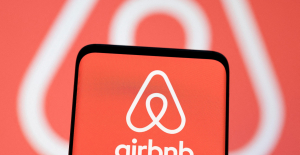After seeing and rewatching that ad for a silk pillowcase popping up while you were leisurely scrolling on Instagram or TikTok, did you end up breaking down and buying it? Don't worry, you are not alone. These targeted advertisements based on your tastes and interests are even the basis of the economic model of these sprawling social networks. And during this period of Black Friday - which takes place this Friday, November 24 - and therefore massive promotions, it can prove even more difficult to resist.
Maureen, 28, describes herself as “a victim of the consumer society”. A few months ago, she said she was “harassed with ads” for a lingerie brand after taking a look at its Instagram page. “I kept getting ads on all my networks. Then I saw a private sale, so I bought tights from this brand,” she admits. Tights with which the young woman is ultimately not very satisfied. Emma, 24, tells a very similar story: “I often saw adverts for a beauty box brand. One day, I saw a story from an influencer on Instagram promoting a limited edition of this box. I went to the brand’s website and bought one.”
In addition to the fact that it is based on personalization via the massive collection of users' personal data, "targeted advertising is based on the principle of repetition", explains Elisabeth Tissier-Desbordes, professor emeritus of marketing at ESCP Europe . “The more you repeat the ad, the more likely the Internet user is to see it and integrate it into their reasoning.” This is what every brand seeks: “to stay in the consumer’s mind, to remain “top of mind” as they say,” explains the consumer behavior specialist. It is because the consumer will have seen or heard about the brand in the preceding days or weeks that they will think about it and make the purchase. “And then, with targeted advertisements, you have the impression that we are speaking to you, so it is a more comfortable situation to initiate a relationship with a brand,” adds David Robin, partner at Colombus Consulting specialized in digital marketing.
Also read: Black Friday: watch out for “dark patterns”, these manipulation techniques that lead you to buy
Proof of the power of targeted advertising, around one in two French people (47%) say they have already been influenced by advertising on social networks to make a purchase, according to a survey published in June 2022 by Capterra. That is to say, a greater power than the content published by influencers (31%). However, another more recent study, carried out by Odoxa for the Federation of e-commerce and distance selling (Fevad) and published last February, calls these results into question, showing that the French are now more inclined to believe “a person (known or not) who speaks sincerely about a brand or who uses/wears it” than “well-made and attractive advertising” (51% versus 46%).
Regardless, targeted advertising remains omnipresent on all major social platforms. “It’s the engine of everything, it’s a big money maker for social networks,” underlines Maria Mercanti-Guérin, lecturer at the IAE in Paris and specialist in digital marketing. A study by the Council of State published last year noted, for example, that “Facebook’s targeted advertising turnover reached $95 billion in 2020, or 40% more than in 2019.” Despite its sometimes repetitive nature, targeted advertising is nevertheless popular with Internet users, according to certain studies, in that it allows them to see more products that correspond to their expectations. “A pop-up ad annoys me and makes me close an app. But when it’s targeted and well targeted, it saves me time by showing me products that interest me,” says Pauline, 33.
There is, however, another side to this coin. “If, for example, you have expressed an interest in decoration, your news feed will be invaded by the same advertisements, which will sometimes be repeated 15, 16, 17 times. This saturation of preferences can be tiring for the consumer,” observes Maria Mercanti-Guérin. Boutayna, 36, can attest to this. “I often get angry about these advertisements because I find them inappropriate, polluting the mind and very caricatured in our navigations,” laments the thirty-year-old, who considers them “repetitive, not very subtle and confining in certain statuses”. She remembers, for example, a time when she was interested in a day cream, which led to “for days of advertisements for facial massages that make you look younger, especially in English”.
Be careful of the backlash for social networks, warns Maria Mercanti-Guérin. “By seeing more advertisements for brands in your feed than messages from your friends, this can create a feeling of rejection by degrading the user experience, and thus trigger escape mechanisms. That is to say, seeing people abandon the networks because of too much advertising,” judges the doctor of management sciences. For the moment, the social media model based on targeted advertising does not seem to be called into question. Even the recent EU decision targeting Meta, parent company of Facebook and Instagram, to prohibit “all processing of personal data for the purposes of behavioral advertising” does nothing. In response, Mark Zuckerberg's group set up a paid subscription without advertising at 9.99 euros per month. Meta agreeing, in exchange for this subscription, to no longer collect the user's personal data for advertising targeting purposes. Users who refuse to subscribe must in this case accept personalized advertisements.
A choice that Marion, 28, refused to make, “annoyed” by this new usage policy and tired of seeing “more and more targeted publications that didn’t interest [her]”. “Currently I have random access to Facebook and Instagram during the day, for a few minutes, before the page comes back to “use the application for free”,” she explains. But the question of compliance with the European regulation for the protection of personal data (GDPR) of the alternative proposed by the American group still arises. “This will only last for a while, because the European Commission has not said its last word,” says Maria Mercanti-Guérin. What Brussels and the European Cnils want is the end of targeted advertising, so they will find another way.” Conversely, David Robin, from Colombus Consulting, sees Meta “finding a solution” to save its model. The standoff is only just beginning.

 Who was Dror Or, the Israeli father who died as a hostage in the hands of Hamas?
Who was Dror Or, the Israeli father who died as a hostage in the hands of Hamas? “Pay in cash”: at his trial, Donald Trump faced with an embarrassing recording
“Pay in cash”: at his trial, Donald Trump faced with an embarrassing recording Italy: a grandmother accidentally serves a bottle filled with wine to a baby, he has an alcoholic coma
Italy: a grandmother accidentally serves a bottle filled with wine to a baby, he has an alcoholic coma The mysterious skeletons of Hermann Göring's villa
The mysterious skeletons of Hermann Göring's villa Children born thanks to PMA do not have more cancers than others
Children born thanks to PMA do not have more cancers than others Breast cancer: less than one in two French women follow screening recommendations
Breast cancer: less than one in two French women follow screening recommendations “Dazzling” symptoms, 5,000 deaths per year, non-existent vaccine... What is Lassa fever, a case of which has been identified in Île-de-France?
“Dazzling” symptoms, 5,000 deaths per year, non-existent vaccine... What is Lassa fever, a case of which has been identified in Île-de-France? Sánchez cancels his agenda and considers resigning: "I need to stop and reflect"
Sánchez cancels his agenda and considers resigning: "I need to stop and reflect" Health carpooling, this source of savings which arouses the ire of patients and taxis
Health carpooling, this source of savings which arouses the ire of patients and taxis Tesla Model 3, MG4 and Dacia Spring.... With the end of the ecological bonus, these electric cars produced in China are seeing their sales fall
Tesla Model 3, MG4 and Dacia Spring.... With the end of the ecological bonus, these electric cars produced in China are seeing their sales fall For the 2024 Olympics, Airbnb commits to fighting prostitution in its accommodation
For the 2024 Olympics, Airbnb commits to fighting prostitution in its accommodation “Shrinkflation”: supermarkets obliged to alert their customers from July 1
“Shrinkflation”: supermarkets obliged to alert their customers from July 1 The electro of Justice and the echoes of Portishead
The electro of Justice and the echoes of Portishead 1924 Olympic Games: according to his daughter, the hero of Chariots of Fire was “not a bigot”
1924 Olympic Games: according to his daughter, the hero of Chariots of Fire was “not a bigot” The “German Brothel” in Yvelines: an uncertain future for the ruined residence
The “German Brothel” in Yvelines: an uncertain future for the ruined residence The eye of the INA: when Paul Auster visited Bernard Pivot
The eye of the INA: when Paul Auster visited Bernard Pivot Omoda 7, another Chinese car that could be manufactured in Spain
Omoda 7, another Chinese car that could be manufactured in Spain BYD chooses CA Auto Bank as financial partner in Spain
BYD chooses CA Auto Bank as financial partner in Spain Tesla and Baidu sign key agreement to boost development of autonomous driving
Tesla and Baidu sign key agreement to boost development of autonomous driving Skoda Kodiaq 2024: a 'beast' plug-in hybrid SUV
Skoda Kodiaq 2024: a 'beast' plug-in hybrid SUV The home mortgage firm rises 3.8% in February and the average interest moderates to 3.33%
The home mortgage firm rises 3.8% in February and the average interest moderates to 3.33% This is how housing prices have changed in Spain in the last decade
This is how housing prices have changed in Spain in the last decade The home mortgage firm drops 10% in January and interest soars to 3.46%
The home mortgage firm drops 10% in January and interest soars to 3.46% The jewel of the Rocío de Nagüeles urbanization: a dream villa in Marbella
The jewel of the Rocío de Nagüeles urbanization: a dream villa in Marbella Facing Jordan Bardella, the popularity match turns to Gabriel Attal’s advantage
Facing Jordan Bardella, the popularity match turns to Gabriel Attal’s advantage Europeans: a senior official on the National Rally list
Europeans: a senior official on the National Rally list Blockade of Sciences Po: the right denounces a “drift”, the government charges the rebels
Blockade of Sciences Po: the right denounces a “drift”, the government charges the rebels Even on a mission for NATO, the Charles-de-Gaulle remains under French control, Lecornu responds to Mélenchon
Even on a mission for NATO, the Charles-de-Gaulle remains under French control, Lecornu responds to Mélenchon These French cities that will boycott the World Cup in Qatar
These French cities that will boycott the World Cup in Qatar Monaco - Clermont: Minamino cornerstone, Fofana essential, the Clermont defense overwhelmed... The tops and the flops
Monaco - Clermont: Minamino cornerstone, Fofana essential, the Clermont defense overwhelmed... The tops and the flops Gymnastics: two gold medals for the Italian Manila Esposito during the European Championships
Gymnastics: two gold medals for the Italian Manila Esposito during the European Championships Champions Cup: in pain, Leinster beats Northampton and qualifies for the final
Champions Cup: in pain, Leinster beats Northampton and qualifies for the final Liga: Real Madrid crowned champion of Spain after FC Barcelona's defeat in Girona
Liga: Real Madrid crowned champion of Spain after FC Barcelona's defeat in Girona


















